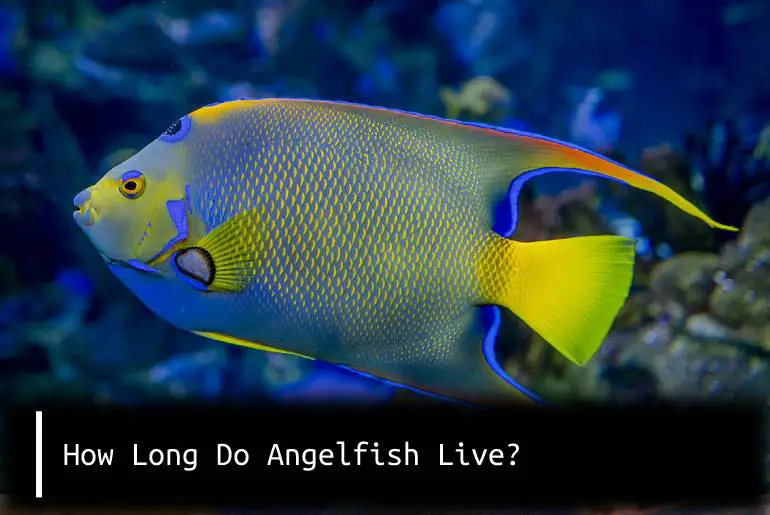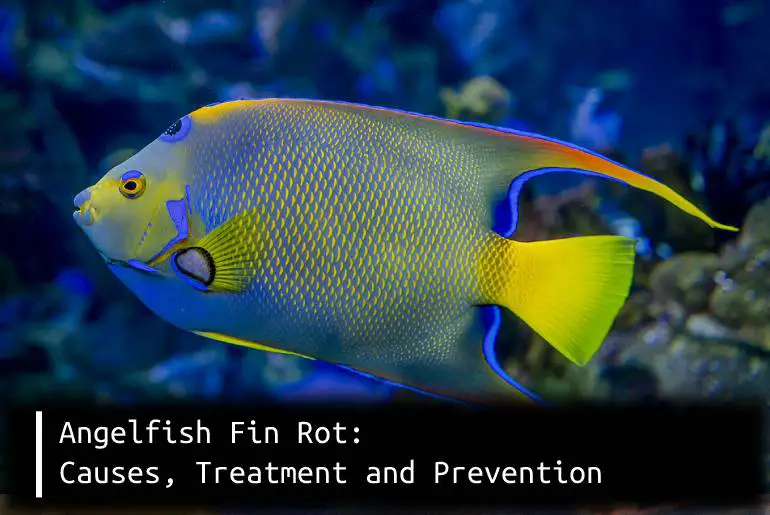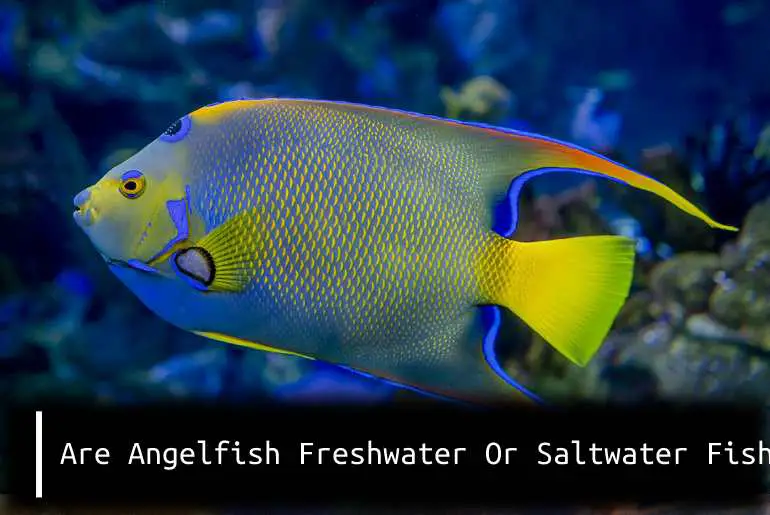Undoubtedly, Angelfish is one of the most beautiful fish you can get for your freshwater aquarium. Usually, their mesmerizing color makes you breathless. But what if their color starts changing? Is it normal? Can angelfish change color?
The answer is yes! Angelfish do change color, but not as often as you might think. Also, sometimes, their color change might indicate something else going on. For example, angelfish usually change color during stress, aggression, illness, or spawning. In addition, your beautiful little guys can change color during excitement or due to a new environment.
Generally, color change is the most talked about topic among many aquarists enthusiasts. So, today we will dig deeper to know the reasons that cause a color change in angelfish, along with ways to care when it happens. Trust me, all the things I have mentioned are tried and tested, so you do not need to worry.
But before we go further, let’s first understand what makes up the angelfish color.
Why Are Angelfish Colorful?
Angelfish are some of the most popular freshwater aquarium fish for a good reason: these fish are absolutely beautiful, with their bright colors and elegant fins. But have you ever wondered why your angels are so colorful?
The answer has to do with something called chromatophores. Chromatophores are cells in the skin of animals that contain pigments, and they are what give animals their color. For example, angelfish have three types of chromatophores in their skin: xanthophores, erythrophores, and melanophores.
Xanthophores contain yellow pigments, erythrophores contain red pigments, and melanophores contain black or brown pigments. The combination of these three types of chromatophores gives angelfish its beautiful colors.
But what about when angelfish change color? Can your angel control their chromatophores, and if so, why would angels want to do that?
How Can Angelfish Change Color?
As mentioned above, the chromatophore cells in the skin of an angelfish are what give the color. These cells store pigments that reflect light and can change the way light reflects depending on the needs of your angelfish. For example, if an angelfish needs to camouflage itself, it will change how chromatophore cells reflect light to match its surroundings. Do angelfish like light? Find out here.
The chromatophore cells in the skin of an angelfish are also responsible for another interesting phenomenon – iridescence. Iridescence is when light reflects off of an object in such a way that it creates a shimmering or rainbow effect.
While the iridescent colors on an angelfish are usually blue or green, they can also be other colors like pink, purple, or orange. These colors originate from light reflecting off multiple layers of cells in the fish’s skin. The number and thickness of these layers determine the exact colors.
However, the color change in your angelfish requires a lot of energy. Therefore, you won’t find your babies changing their color often. Moreover, if you’re interested in seeing your angelfish change color, you’ll need to provide it with plenty of food and a stress-free environment.
Can Angelfish Change Color?
The fascinating answer to this question is that yes, they can! Angelfish can change color to adapt to their surroundings and better camouflage themselves from predators. This ability to change color is called metachrosis, and it’s something that many fish can do, not just Angelfish.
Actually, the color change is one of the interesting things about angelfish. I bet you can’t take your eyes off them when they do it! But do you know why they do it?
Why Do Angelfish Change Color?
A color-changing fish is an exciting thing to behold. Many aquarists are curious about why their angelfish change color. The truth is, there are a few reasons why this happens. Sometimes it might be natural, while sometimes, it might indicate something going wrong with your fish.
So, here are the reasons why Angelfish change color:
Angelfish Change Color During Hunger Strikes
The first reason why your angelfish might be changing color is hunger. When fish are hungry, they tend to lose their color. Usually, food contains carotenoids responsible for giving your little guys vibrant hues.
So, when you do not feed your Angelfish properly. Your angelfish will start to change color. You might notice that your angels’ colors will become dull and white. Moreover, due to the lack of nutritious and adequate meals, your sensitive pet might be unable to fight various diseases. Eventually, this can also lead to color change in your angels.
Angelfish Change Color When Stressed
Angelfish also change color during stress and anxiety. When your angels feel stressed, their bodies produce a hormone called cortisol. This hormone affects the fish’s coloration and can cause them to turn pale or even white.
Stress can occur due to several reasons, such as changes in the water quality, improper diet, or even being bullied by other fish. For example, if you notice that your angelfish are changing color, it might indicate that they are stressed. Hence, you should take steps to alleviate the environmental stressors soon.
Angelfish Change Color When Breeding
Angelfish might also change color due to breeding. These fish are known to change color when they are ready to mate. The male fish will usually turn a darker color while the female fish will turn a lighter color.
This attracts mates and is a natural part of the breeding process. If you notice your angelfish changing color, it might indicate that they are ready to breed. Just observe the following signs: males following females, bulging in the female stomach, aggression toward tankmates, and pairing.
When you notice these signs in your Angelfish, keeping your fish separate in a breeding tank is best. By doing so, you can help your little ones in breeding and improve their colors too.
Angelfish Change Color Due To Illness
If you have an angelfish, you should be cautious that these fish are sensitive. Do not make mistakes like me and oversee their signs of illness. You might not know this when you bring angels into your home. But sometimes, the color change of angelfish indicates serious health issues.
Some of the diseases I have tackled over the years are Ich, fin rot, dropsy, Hexamita, gill fluke, and gold dust diseases. And your angel changes color during all these conditions. While sometimes, the color may get darker, and sometimes it fades. Hence it is very important to observe your angelfish carefully and never neglect these signs.
Of course, the color change is not the only sign of diseases in angelfish. Look for other signs like lethargy, loss of appetite, abnormal swimming behavior, clamped fins, or gasping. If you see all these signs in your fish with color change, it is time to take action immediately.
During Sleep
This might surprise you. There is a unique and interesting fact about angelfish that you might not know initially. Have you ever looked at your aquarium and wondered where your fish go?
Actually, this has happened to me several times. Angelfish are also known to change color when they are sleeping. These notorious little guys camouflage with the environment and hide while taking a rest.
Generally, angelfish body temperature drops, and the blood vessels in their skin constrict. As a result, it causes your babies to turn a lighter color. If an angelfish is resting on a light-colored substrate, it will turn lighter to match the color of the bottom. If it’s resting on a dark-colored substrate, it will turn darker to match the color of the bottom.
So, don’t worry if you notice your angelfish disappearing sometimes. Your pet might be taking a rest. It is normal.
Shifting Angelfish In New Environment
A new environment is very suspicious, whether for humans or pets. Humans being highly intellectual, as they are said, also need a lot of adjustments and time to align with their newer surroundings. Just like this, Angelfish also needs time.
Giving your angels time and consideration whenever you change the aquarium is crucial in angelfish care. Usually, angelfish are not as hardy as you might assume. So, some changes can affect them a lot.
Generally, when you shift angels to a new tank or location, they might change color to adjust to the new surroundings. This is perfectly normal and should not be cause for concern. Angelfish are very adaptable creatures and usually adjust to their new environment within a few days.
If you notice that your angelfish are changing color, don’t be alarmed. In most cases, it is nothing to worry about and is simply a natural part of their life cycle. However, if you notice other symptoms, such as immobility, not eating, or excessive hiding, it might actually be a matter of concern.
When Angelfish Gets Old
Oldage is dangerous. You become weak, your body functions slow down, and whatnot. Unfortunately, like humans, Angelfish also becomes fragile with age. Their body functioning and melanin production gradually reduces. As a result, your best and most beautiful buddy might start losing its charm and color.
Usually, as your angelfish age, their colors start to fade and even turn white. This is a natural part of the aging process and is nothing to be concerned about. I am sure you would not like it, but you can’t do anything about it. It’s a natural process that is bound to happen one day. Just take care of your little guys and focus on giving them the best possible life before they leave you.
As you can see, there are a few reasons your angelfish might change color. When you notice that your fish are changing color, it is important to observe them closely and look for other signs of stress or illness. Your angelfish will be healthy and vibrant for many years with proper care and attention.
How To Know That The Color Change Of Angelfish Is Serious?
Color change in Angelfish is confusing; sometimes, your fish look sick when actually they are not. Usually, the change in coloration of your angelfish can signify either good or bad health. So, to settle the confusion, here are a few other signs that can help you detect if your Angelfish color change is due to some health reason or not.
Loss In Appetite
Angelfish are voracious eaters. In fact, as angels are omnivores, you will see your pet enjoying everything you feed them. So, when your Angelfish is not eating properly or is avoiding food at all, it is a sign of concern.
Most commonly, I found my angels losing their appetite during illness or health issues. Besides this, your babies might even be sensitive and can be stressed out. If you notice your pet not eating, try changing their diet, monitor their water parameters, and look whether your babies are being bullied or not.
Furthermore, I suggest you always feed nutritious food to your angelfish and in the right amount. You might obviously end up overfeeding or underfeeding your angels when you are new. However, after some trial and error, you might know what’s right for them.
Note: One important thing that you should never miss is removing food after your angelfish have finished eating. Usually, it is best to clean the tank and removes uneaten food after 15-25 mins of feeding. This will not only make your aquarium clean and healthy but also reduce the chances of angelfish diseases.
Clamped Fins
Angelfish, long and flowing, is one of the best parts about them. I feel their fins are the key reason for their attraction. I can’t imagine my babies without their wonderful fins. Whenever my angels swim around flaunting their fins, I just can’t stop admiring them.
However, when angels are not well or struggling through something, the first sign that you might notice is the change in fin color and clamping. Usually, health issues like fin rot, ich, and parasite infections affect your angels’ fins a lot. Besides this, keeping your little ones with the wrong tankmate will lead to fin nipping and flared fins.
Fins are angelfish’s beauty. So, take care of this sign and try alleviating this issue before it becomes late.
Change In Behavior
Angelfish are active and notorious creatures. You might see them swimming around in their group, hiding, exploring places, and moving. Apart from resting, you will probably find your angelfish always moving or swimming.
Thus, when your angel’s behavior suddenly changes into being shy and aggressive, it signifies something bugging them. Likewise, it changes color and behavior when you fail to keep your little guys in an appropriate environment with proper water parameters, tankmates, and vegetation.
Always remember a change of coloration, along with all these signs, is fatal. You need to take action immediately. Otherwise, you might lose your fish and their beautiful color. It is always better to be safe than sorry when it comes to the health of your beloved pet!
But how to stop angelfish from changing color?
How To Maintain The Color Of Your Angelfish?
Some aquarists just assume that if they could stop angelfish from changing color, it would help to maintain Angelfish’s beauty. But it is practically impossible to stop angelfish from changing color. By now, you might know that color change is a natural process that can’t be stopped.
However, you can maintain the color of your beautiful angels. The mesmerizing yellows, oranges, deep blues, and reds of your angelfish can be maintained. All you need to do is provide a healthy and happy environment for your little guys.
Despite being a natural process, color change might be a hazardous sign. Therefore, you should never neglect it. Generally, here are some ways to maintain the color of your angelfish:
Feed Quality Diet
What you eat reflects in your skin, which also applies to angelfish. Therefore, a well-balanced diet is necessary if you want glowing and colorful angelfish. Most commonly, the nutrition provided by healthy food is vital for coloration and melanin formation in angelfish.
Since angelfish is an omnivores, you need to provide them with a protein-based and plant-based diet for better health. Usually, I give my little guys flakes, pellets, freeze-dried, frozen, live foods, and vegetables. My babies like bloodworms, brine shrimps, and Mysis shrimp the most. I often switch between these options and add a few veggies to each meal.
Some of the products that are beneficial for angelfish are:
- Omega one pellets
- Ocean Nutrition Instant Baby Brine Shrimp 0.7-Ounces (20 Grams) Jar
- Omega One Freeze-Dried Blood Worms, 0.96 oz
- 200 Live Daphnia by Aqua L’amourl
- Hikari Bio-Pure Freeze Dried Daphnia for Pets, 0.42-Ounce
- Hikari Tubifex Worms Fish Food (0.7 oz.) [Set of 2]
You can also try these. Always give your angelfish proper amount of food that promotes their growth and health. I usually give my angels meals twice a day. You can increase or decrease the frequency as per your need. But always remove the uneaten food from the tank.
Hopefully, this will help improve your angelfish color.
Provide Proper Lighting
As mentioned above, angelfish are active fish that love to explore different places. Besides this, proper lighting helps to make your little ones safe and secure. Generally, Angelfish belong to a natural habitat where these fish can get enough amount of sunlight and shade.
However, you cannot always practically create an environment that replicates their natural habitat. But you can still try to get close to it. With my experience with angelfish, I cannot deny that proper lighting is necessary to bring out the colors of fish. Usually, with the proper lighting, you will find your angelfish more active, happier, and healthier.
There is much scientific evidence that lighting positively impacts the chromatophores of your angelfish. And with my years of angelfish-keeping experience, I cannot deny this claim. Moreover, the intensity and duration of the light will depend on the type of plants you have in your aquarium. So, you’ll need to provide more light if you have live plants.
I mostly prefer keeping my tank in an area with proper sunlight. But if you do not have this option, you can use fluorescent bulbs, LED lights, or metal halide bulbs. It all depends on what’s best for your angels.
Change The Water Regularly
Angelfish is not the cleanest of fish. Your little angels will dirty the aquarium a lot. Therefore, you must change the water regularly to keep the water clean and free of toxins.
Moreover, a tank full of toxins will be a perfect environment for parasitic infections to grow and flourish. In addition, an uncleaned tank will also increase health issues and illness in angelfish. All these, in one way or another, affect the coloration of your angels.
Thus, water changes and cleaning are vital to maintaining your fish’s color. Most aquarists change around 25% of water every week. You can also follow the same or change a little more of it. But you should always be careful not to change all the water at once as it will shock your fish. Instead, just do it gradually over a period of time.
Use An Aquarium Filter
As mentioned, angelfish produce a lot of waste and toxins. But water changes might not always be an option, and too frequently, water changes can also be fatal to health. So, instead, you can keep your aquarium clean using different types of filters.
An aquarium filter eliminates toxins and provides a healthier environment for your angelfish. So, with health comes a brighter and glowing color in your little ones. But do remember to should also clean the filter regularly. Your water cleaner also needs some cleaning.
Furthermore, you must be cautious about where to keep the filter. Otherwise, your angels might get stuck in it. I usually like an incandescent filter and use it in my aquarium. But different filters are available in the market, so choose one that is best for your aquarium.
Fluval FX6 Canister Filter could result in one of the best filters for an angelfish aquarium in my own experience.
Monitor Water Parameters
Water parameters play a major role in a better and healthier life for angelfish. Unfortunately, although your little guys can handle little fluctuations, they are still not good for their health and coloration. So, you need to monitor these parameters regularly and make necessary adjustments to keep them within the desired range.
- The temperature of 78 to 84 degrees Fahrenheit
- The hardness of 54 to 145 ppm (3-8 dkH)
- pH slightly alkaline (6.8-7.8)
- No ammonia
- No nitrite
- Nitrate around 20 ppm
Moreover, you can use different testing tools to monitor the water parameters. Further, insert heaters, live plants, substrates, and air pumps so that the water conditions always fall within the range. If you could maintain ideal water, I am sure you will find your angels glowing.
Maintain A Stress-free Environment
Your Angelfish is sensitive to any changes in the environment. So, these little guys and prone to stress. A stress-free environment is necessary for the health of your fish. Avoid using harsh chemicals in your aquarium, as they can harm your fish. Also, make sure that there are no loud noises or bright lights near the aquarium.
Furthermore, ensure that your tank size is perfect for your angelfish to grow, explore, and keep them in appropriate tankmates. If you maintain a stress-free environment, your angelfish will be less like to fall ill. As a result, your pet’s color can be enhanced and maintained.
So, there you go. All these are some ways to maintain the color of your angelfish. Follow these tips, and you’ll be able to keep your fish healthy and their colors bright.
FAQs
Is The Color Change Of Angelfish Permanent?
It usually depends on the type of color change. For example, if an angelfish changes color due to a disease, the color change is likely to be permanent. However, if the color change is due to stress, it is usually temporary, and the fish will return to its original color once the stressor has been removed.
Do Angelfish Camouflage In Their Environment?
Angelfish are known to change color to camouflage themselves in their environment. For example, if you place angelfish with many green plants, it may change its color to green to blend in.
Can Angelfish Change Color On Their Own?
Yes, Angelfish can change color on their own. However, they usually only do this in response to a change in their environment, such as changing the water temperature or adding new fish to the tank.
Why Is My Angelfish Turning Black?
If your Angelfish is turning black, it could be due to several factors, including stress, disease, or old age. If you are concerned about your fish’s health, it is best to consult a veterinarian.
Conclusion
In conclusion, Angelfish can change color for a variety of reasons. Some of these reasons are simply due to the fish’s environment, while others may be related to the angelfish’s health or mood. However, the most common reason an angelfish changes color is its natural camouflage instincts. So, if you see an angelfish that looks slightly different than usual, don’t be alarmed! It’s probably just doing what comes naturally.
Do you have any other questions about angelfish? Let us know in the comments below! And be sure to check out our other blog posts for more fish-keeping tips and advice.
Happy Fish Keeping!






